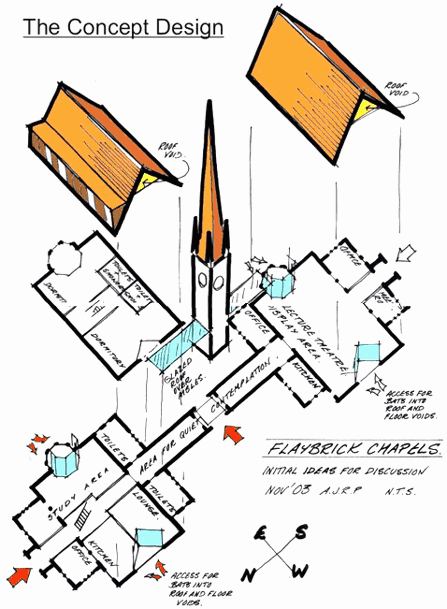Flaybrick National Bat Study Centre (Wirral)
The Project
Guidelines / Brief
1. Renovating the chapel building, in full/part to house bat study centre
with under-floor Hubernacula and Nursery roost facilities, study centre,
lecture theatre, offices, dormitory and living space. The restoration
would include the re-roofing of the two main chapel buildings and vestibules,
the re-erection of the 100ft spire and the opening of the walk.
The ground management will involve planting night scented plants to attract
insects, also the creation of “pond scrapes” to encourage other
wildlife.
The process of encouraging a specialist predatory species to increase its use of an area, can only be achieved by a systematic increase in the natural biodiversity of an area. Whilst most of the ground management in the Memorial Gardens will be limited by the obvious use of the burial facilities, there are places where the increase in habitat can be achieved. Management for the increase of habitat will also extend onto Bidston Hill SBI (a neighbouring site, of 127 acres of mixed woodland, wet heath, lowland heath and amenity grassland, located across Boundary Road). Ground Management will include:-
- Creating
several small pond areas/habitats to increase biodiversity and provide
water for bat species.
- Wild
flower area creation Rose Bay Willow Herb, Sallow and Soft Rush, Iris
around pond margins should increase insect diversity.
- Marginal
wildflower areas around walls and areas not used for headstones. Possible
stewardship involvement.
- Continued
management of the woodland/ grassland/ heath fringes good hunting areas
for bats.
- Creation of some clearings to allow ground flora to grow and encourage insects.
- Planting
of night scented, native species on Bidston Hill and some ornamental
planting in Flaybrick Memorial Gardens.
- Creation
and management of feeding corridors along pathways and around sites
containing water.
- Re-generation
of pine woods new trees planted in clearings, including some alternative
species.
- Improve
ground cover by native species in open clearings (bramble, Nettle etc)(temporary
fencing maybe required to prevent trampling)
- Erection of Bat boxes made by local schools, throughout woodland (and some form of licensed monitoring scheme). In the Eco building, workshop at Tam O' Shanter Urban Farm. Surveying bats leaving these purpose built homes “not disturbing the roosts”.


The Friends of Flaybrick are backed by...
![]()
